Since finishing my graduate thesis project this in August of 2011, does not mean that I have stopped my research on temporary sheltering and post-disaster events. After spending a year designing the “Sofortig(a) Shelter,” I want to keep up on sheltering options that would be feasible for a United States application (the Cocoon, the Pallet House, the Concrete Canvas Shelter, the Sanctuary House, the Cardboard House, and Studio D’s temporary sheltering option).
In the times after a natural disaster, it is beneficial, both physically and psychologically, to be in communication with other people who were also affected by the natural disaster. The Sphere attempts to accomplish this by providing nineteen separate units, which creates a circle layout. By being in a circle or sphere layout, the center of the shelter can be used as a social center. This provides the users the ability to interact with individuals who are in a similar situation; therefore, helping them to get over the destruction they faced. The Sphere Shelter, combining nineteen unite, provides the users with the opportunity to get into contact with others; therefore, the Sphere Shelter “becomes a germ cell for a community who is working properly” (Sphere-shaped para 1).
Image 1 - A daytime view of the Sphere Shelter
Image 2 - A view of multiple Sphere Shelters grouped together
Each of the nineteen separate tents can house three individuals; however, the partition walls can be detached to create a larger livable space for a growing family. The Sphere Shelter is comprised of both an exterior and as interior fabric material. The exterior fabric material is waterproof. On the other hand, the interior material is made from a permeable nylon ripstop material. The interior material, by supplying a ripstop material, helps prevent the material from ripping due to extreme weather. In addition, fiber glass plastic stakes are incorporated to securely attach the shelter to the ground. Unlike the FEMA trailer, which was used once and discarded, the Sphere Shelter, by incorporating the above materials, can be completely recycled if needed after its use.
Due to the government’s ill-preparedness during a natural disaster, there is a need for a designed temporary shelter to replace the expensive FEMA trailer. Michael Daniels, a senior designer at Frog Design, took this situation as a design challenge when he designed the Reaction House. His emergency shelter was designed to facilitate rapid shelter deployment, wile supplying the users with a complete unit, including infrastructure, interior furnishings, and wiring for utilities. To remain affordable, Daniel’s shelter costs $5,000 and can be reusable, which is a great feat when compared to the $65,000 FEMA trailer. In addition, in the events of a large family, these Reaction Houses can be combined together, supplying as much usable square footage as possible.
Image 3 - The Reaction Shelters being unloaded from a cargo boat
Image 4 - Showing how a commnity of Reaction Houses would be incorporated
To exploit the rapid deployment aspect, these shelters can arrive to a designated location via truck, railway, waterway, and/or airplane. In addition, four people can unload the shelter, as well as set it up without the use of tools. These shelters can be deployed in two situations, soft and hard deployment. Soft deployment is a set up which utilizes the existing facility for power, sanitation, and food services. Therefore, the shelter is only used for living and sleeping. On the other hand, a hard deployment would consider the shelter as an independent structure, which would be powered by a generator. In addition, the shelter would have their own small kitchen, climate controls, and sanitation system. On the other hand, a few elements would need to be incorporated to create a more successful independent shelter. These things would include: solar panels, solar batteries, and a cistern system.
Text
Meinhold, B. (208, November 28). Prefab Friday: Reaction Housing Emergency
Shelters. Retrieved October 15, 2001, from http://inhabitat.com/prefab-friday-
housing-emergency-shelters
Sphere-Shaped Emergency Shelter Bonds Community. (2007, August, 14).
Retrieved November 15, 2001, from http://yankodesign.com/2007/
08/14/sphere-shaped-emergency-shelter-bonds-community




No comments:
Post a Comment